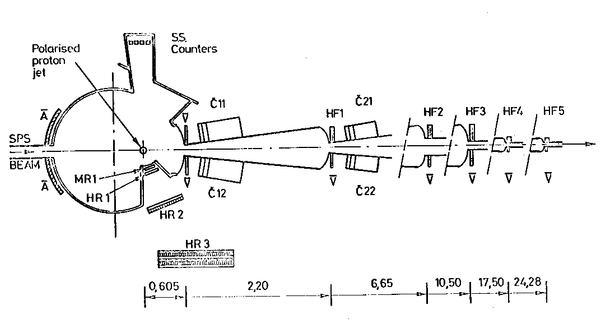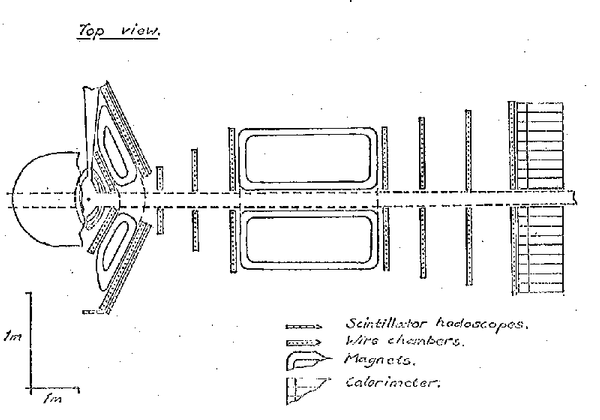
Figure 1
Intent to study anti-p p reactions at a cm energy of 22 GeV.
Study of spin effects in proton-proton reactions at the SPS using a polarized atomic hydrogen jet target.
A proposal has been submitted at CERN to use an available polarized proton source to produce a gas jet of polarized protons, which can be brought in collision with the circulating beam of the SPS. The proposed layout is shown in fig 1. The experiment aims at investigating the polarization in elastic proton-proton scattering and isobar excitation of the high-energy proton in the Coulomb interference region; polarization in elastic scattering over medium momentum transfers up to the diffraction minimum; and asymmetries in inclusive production of neutral pions.
There has been a considerable increase in interest for polarization effects in e.g. proton-proton elastic scattering high energy collisions after recent observations of remarkable polarization effects at the ZGS at Argonne and in the production of lamda with high transverse momentum at the FNAL.

Figure 1
Intent to study anti-p p reactions at a cm energy of 22 GeV.
The studies leading up to our proposal for polarisation studies using a gas jet In the SPS has drawn our attention to several desirable features of the internal/multitraversal target technique. In view of the request by the SPSC to submit proposals or letters of intents for the use of the anti-p facility in the SPS, we are inside the collaboration preparing a letter of intent to use the multitreversal target technique for studying anti-p p and anti-p nucleon reactions. In one mode of operation, parasitic on the use of the antiproton-proton interacting beams experiments, we foresee a target thin enough so that over a 10 h run only a small fraction of the p beam, say 10% is consumed. With a p-beam of 5*10**11 this leads to a luminosity of 5*10**31 cm-2s-1. The target would be a jet of very cold hydrogen gas, a technique which has been developped for other purposes by a group in Karlsruhe and produces very dense and well localised jets. The circulating antip-beam is bunched with a duty ratio of 1/2000 and with this luminosity one will expect to have several events occuring within each 2 ns bunch, which would be impossible to separate in the analysis.
In the second mode of operation we propose to use the antiprotons left in the machine after a run with intersecting antip-p beams, before refilling the ring with fresh antiprotons and protons. Since refilling time is set more by the deterioration of the beam quality than beam intensity, most of the stored antiprotons would still be circulating. We propose that these antiprotons, rather than being dumped to no purpose, can be slowly absorbed in a thin internal target. For a antp-beam of 5*10**1 being provided every 10 hours, the luminosity available from this target would be 4"10**32. In this mode of operation the beam would be debunched. The prospect to achieve average luminosities with anti-protons in the range from 10**31 - 10**33, as high or higher than the luminosities of the ISR with protons, is to our mind an exciting one, which would well justify the installation of an experimental detector for 22 GeV cm energy physics in one of the free 12 m long straight sections in the SPS tunnel.
Such a facility would be much smaller in solid angle than the corresponding detectors at the ISR because of the collimating effect of the c of m motion. A 6 degree cone would cover the whole forward hemisphere in the c of m system. We are working on a proposal which would cover this cone with a plane of hadron calorimeters proceeded by a deflection magnet with driftchamber detectors for charged particles (fig 2). One of the most interesting features would be the study of e+ e- pairs where we would have the advantage over ISR experiments both in the higher luminosity and the antiquark content of the antiprotons. Other interesting problems is the study of large pt inclusive production with antiprotons and the comparison with the same phenomena in p-p or pi p.
We also propose to use as recoil detector a setup of a counter and chamber telescope, with a magnet. This detector will allow studies of the fragmentation of the target proton in antip-p collisions. An exciting prospect is that in coincidences between the forward apparatus with the recoil telescope large t elastic antip-p scattering can be measured out to very large momentum transfers, as large as was done in p-p at the ISR. In the very low t-range solid state detectors will allow the determination of the real part of the forward scattering amplitude.
An interesting proposition which will be looked into is to use simultaneous measurement of the total reaction rate and of the low t elastic scattering process to make a precision determination of the total cross section, as was done at the ISR, and to calibrate the luminosity of the experiment.
The detector arrangement which we intend to propose for antip-p studies has many features in common with the previously proposed detector for a polarised gas jet for p-p studies. We would in particular aim to allow the use of the polarised gas jet during periods with no antiproton beam.

Figure 2